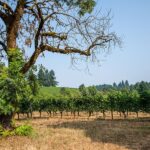Domaine Serene unfolds telescopically as you enter the property, like some hidden world that appears only when you find the right door: 450 precisely manicured acres above Dundee with seven vineyards divided into pristine grids.
Domaine Serene owners Ken and Grace Evenstad have built a world apart from Oregon’s wine community.
STORY BY ANN BAUER // PHOTOS BY JIM GOLDEN
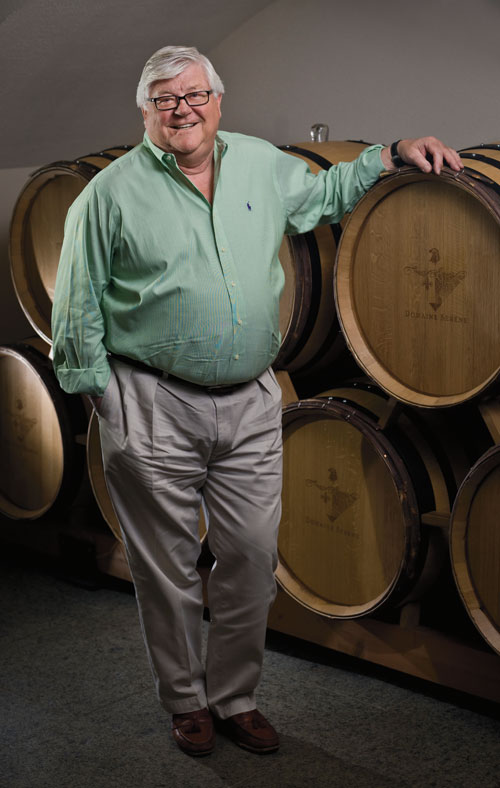 |
| Ken Evenstad built a successful drug manufacturing company in Minnesota, and then bought the property for Domaine Serene in 1989. The winery turned a profit for the first time this year. |
Domaine Serene unfolds telescopically as you enter the property, like some hidden world that appears only when you find the right door: 450 precisely manicured acres above Dundee with seven vineyards divided into pristine grids. This is land as orderly and brilliantly green as the previous miles were rustic and brambly, shades of copper, jade and dun.
The main building is a mammoth Tuscan-style structure: yellow clay with a red-tiled roof. Inside are 50,000 square feet of statuary, columns and 20-foot ceilings. Five levels contain four fermentation rooms, four barrel cellars, a sorting line, corking operation, tasting room and restaurant. The corridors seem endless; framed awards line the walls. This place is cave-like and quiet. Footsteps echo against the terrazzo floor.
And after a time Grace Evenstad appears in the chilly vaulted conference room — a small woman, exquisitely coiffed — and perches on a chair across the massive table. Her husband, Ken, is on the phone with a reporter from Forbes, she explains.
A few minutes later he arrives and the room feels immediately warmer. He’s a bear-like 66-year-old, tall, broad and well-fed, with a ruddy, jowled face and thick white hair. He looks more like a union boss than a CEO, though he’s been at the helm of Upsher-Smith, a thriving pharmaceutical company based in Minnesota for the past 40 years. He extends a hand that’s the circumference of a bread plate.
Then he circles the table and sits next to his wife.
I met Ken Evenstad once before, in July, at his lavish, art-filled office in Maple Grove, Minn., while on assignment for a Minneapolis-based publication to report on the wild success of drug manufacturer Upsher-Smith. And Evenstad had agreed to talk to me about the way he built the business from a dying digitalis factory he purchased for $1,500 in the late 1960s to a major pharmaceutical enterprise with 600 people worldwide and an estimated annual gross income of $250 million per year.
Evenstad was welcoming and amiable. But the only concrete answer he supplied during the hour interview was that he knew how to “meet an unmet need.” I found the only way to draw Evenstad out was to talk about wine. He said proudly that his palate was “extremely good,” allowing him to participate in blind taste tastings with world-renowned wine experts and “hold his own.” Then he told me the story of Domaine Serene — a dream that he’d realized finally in 1989. They had perfected a consistently excellent Pinot Noir, Evenstad said, something French winemakers had failed to do.
Strangely, Evenstad is virtually unknown in what is a robust and well-connected business community. The greater Twin Cities area is home to an enormous number of thriving companies and highly respected leaders. Headquarters in the area include General Mills, US Bank, UnitedHealthcare and Cargill. Yet Evenstad spoke of no ties. No one in business, pharma, or biotech could speak knowledgeably about the man. He works closely with Grace and their son, Mark (president of Upsher-Smith), but appeared to have no other close confidantes.
But perhaps most interesting, during the interview Evenstad used variations on the word “invent” repeatedly— referring to himself not as a pharmacist or a businessman but as an inventor — despite the fact that Upsher-Smith is best known as a manufacturer of generic drugs: preparations designed to be identical to (or very closely mimic) the action of FDA-approved medications, once their patent has run out.
This idea of invention is a key issue in the Willamette Valley community where he and his wife own and operate Domaine Serene.
Ken Evenstad was born in 1943 and raised in a small Minnesota town of about 1,500 people. His father managed the local power plant; his mother was a homemaker and then — after her four children went to school — an assembly-line worker for a pharmaceutical company. The person he admired most as a young man was Theodore Rowell, owner of the factory where his mother worked, a grassroots politician and the richest man in town.
The grandeur of Domaine Serene has earned it the nickname of “Domaine Obscene” by some in the local wine community. |
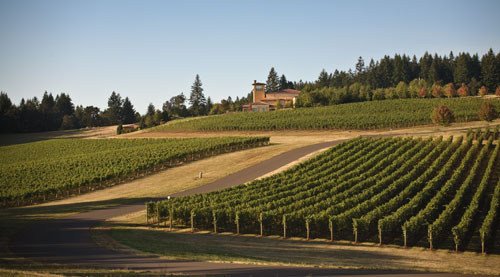 |
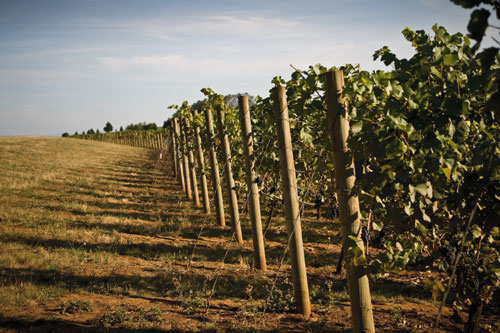 |
 |
In part due to Rowell’s influence, Ken pursued a pharmacy degree from the University of Minnesota, where he met Grace, a nursing student. They married after she graduated in 1966, able to support them as an RN while he finished his Bachelor of Science. He graduated the following year but immediately began worrying about Vietnam. So together, the young couple devised a plan: Ken would volunteer for the public health service somewhere safe — they chose Alaska, because they’d heard the state was in need of pharmacists — and ride out the war.
Shortly before they were to leave, Grace discovered she was pregnant and Ken’s draft eligibility vanished. They no longer needed to ship out to Alaska. Relieved, he wanted to settle near their two families and take a job at the local drugstore. But Grace said no.
Her view was that they’d planned on an adventure no matter what the circumstances, and she intended to follow through. Ken made a call to the state board of pharmacy and ended up talking to the president, who hired him on the spot. Seven months pregnant with their daughter, Serene, Grace packed up their tiny household and orchestrated the move.
“Alaska had been a state for only eight years,” says Grace. A small woman dressed in a soft gray suit with tasteful jewelry and perfectly manicured nails, she is nevertheless steely. “This was a new frontier and there were people more inept than Ken and I running the whole place. It gave me such confidence to see this. That’s when I decided we could do anything we chose.”
Ken Evenstad calls his wife a “stoic” and boasts about her independent streak. Part of the reason they moved north, he confides, was to avoid the obligatory Sunday dinners with her parents. Instead, they found themselves on the wild outskirts of Anchorage and it was here — they both say — that they learned to appreciate fine wine.
Ken’s patron was a former Californian and oenophile who had bottles regularly shipped in. The young couple had never tasted wine before but they loved it. And when they moved back to Minnesota, after a year, they took their new hobby with them — scouring Midwestern liquor stores for decent vintages at a time when martinis and bourbon were all the rage.
A staff pharmacist for a neighborhood drugstore, Ken had ambition. He had no intention, he says, of “counting pills” for the rest of his life. Working after hours, the then-26-year-old invented a shelf-stable solution for potassium iodide, an expectorant used by people with emphysema. This achievement happened to come the same year as the birth of their son, Mark. And when Grace called to tell her aunt about the new baby, she discovered her Uncle Jim was selling Upsher-Smith Laboratories, a digitalis factory founded by her grandfather.
Ken bought Upsher-Smith for $1,500 and traded on the company’s name and contacts to sell his homemade preparation. By the mid-70s, Upsher-Smith had a sizable new manufacturing plant, an integrated line of generic drugs and a staff of about 100. The family-owned company has expanded steadily over the decades into more lucrative fields, including dermatology and women’s health; last year, they bought into a small London-based firm that is developing a promising new drug for Parkinson’s — a disease poised to explode as 75 million baby boomers reach the average age of onset.
While Ken was growing Upsher-Smith, he and Grace raised their children in Wayzata, a posh, lakefront suburb of Minneapolis, and traveled the wine regions of the world. They went to Italy and Germany and took multiple wine tours of France.
By the time he was 30, Ken says he’d decided they would one day own a winery. He set his sights on the Willamette Valley because his favorite was Pinot Noir.
“I had visited Oregon and tasted the fresh fruit, strawberries and cherries, and it had a flavor that I never got in any fruit anyplace else,” Evenstad says. “That ability for fruit to grow transfers into the grapes and especially to Pinot. Here, it has the ability to develop aromatics that I think are more complex and delightful than almost any other wine.”
| The Evenstads say they use unique wine-making methods, but other winemakers say they are merely building on established practices. |
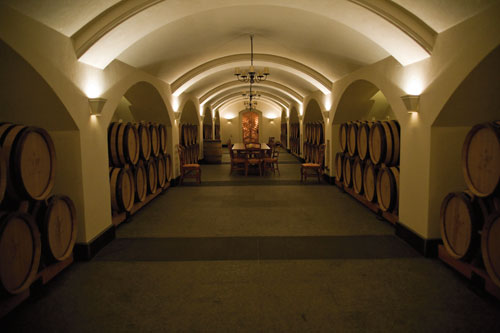 |
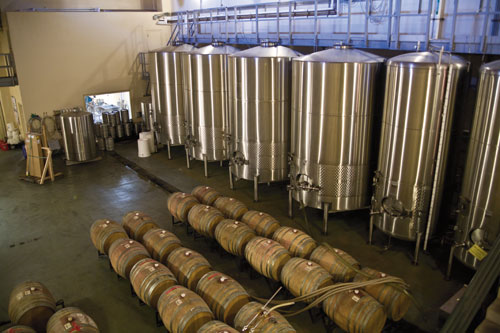 |
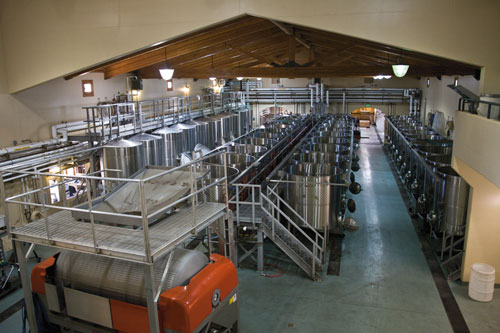 |
But it wasn’t until 1989 that he found the right piece of property. It was a 40-acre plot full of stumps and rocks and dead trees that had to be cleared, but a soil consultant from the University of Oregon confirmed it was a prime place to grow grapes. So Evenstad snatched up the land and spent the next three years clearing it. They began producing wine with purchased fruit almost immediately, planting their own vines in ’92 and reaping their first harvest in ’95.
The winery was Ken’s dream — he was the one with the chemistry background, and a self-professed near-perfect palate — yet it was Grace who managed the day-to-day operations of the winery. Their children were mostly raised, so she spent most of her time in Oregon while her husband attended to the pharmaceutical business back home. She learned to hand-prune the arbors, visited cork factories and worked side by side with master winemaker Ken Wright.
Ken Evenstad would visit the winery for long stretches during harvest, and he took charge of the blending when he was there. But for years, this was his sideline. For Grace, however, it quickly became a full-time occupation. She even managed distribution, calling on vendors all over the country to talk about Domaine Serene.
“Our mission was simply to make consistently excellent Pinot Noir,” Grace says. “We loved Burgundies, Ken and I, but we were disappointed by the variation in quality from year to year. So we decided since the Burgundians were all doing single vineyard and that might be the issue, our method would be a blend of the vineyards. We would make a great Pinot Noir, every single vintage.”
And that, according to the critics, is essentially what they’ve done. Since about 2000, Domaine Serene wines have won industry praise nearly every year. Jay Miller, who writes reviews for Robert Parker’s Wine Advocate, has awarded several of Evenstad’s wines 90 points or above.
“From the very beginning Domaine Serene has been focused on quality,” Miller says. “Their wines are all produced from estate fruit, that is, grapes they have grown in their own vineyards. The wines reflect the vintages from which they were produced. As in Burgundy, no two years are alike; each has its own quirks and personality. Domaine Serene is willing to do whatever it takes to make a high-quality wine.”
Throughout the ’90s Ken phased out of his daily management role at Upsher-Smith, eventually turning it over to their son, Mark, who took over as president in 2003. And he joined Grace at the winery, which now produces more than 25,000 cases a year, including dozens of Pinot Noirs, Chardonnay, Syrah and a rare white called Coeur Blanc that’s made from mature red grapes. They claim it is “an entirely new category of wine.”
Domaine Serene is so out of scale compared to other family-owned wineries in the Dundee Hills it has earned the snickered nickname “Domaine Obscene.” They won’t reveal how much they’ve spent but will say they’ve poured a large percentage of their personal assets into this enterprise.
“Ken had made money quite a bit through the pharmaceutical business and we’ve always lived frugally,” Grace Evenstad says. “We had one home in Minnesota – we still have it, the home where we raised our kids. It’s not on the lake. We decided we wanted to put our money into this business and over the years that’s exactly what we’ve done.”
This year, for the first time since its inception, Domaine Serene turned a profit and became self-sustaining. Nationally they are winning accolades, including “Year’s Best Pinot Noir” from Wine & Spirits in April 2009. But locally the Evenstads are regarded with suspicion. They are considered out-of-towners, wealthy hobbyists, who arrived 20 years ago from Minnesota talking about how they planned to improve Oregon’s wine industry. Now, they claim they have.
“Ken and Grace have been quoted as saying they’re responsible for the entire wine industry and winemaking techniques going back to Jesus,” says Harry Peterson-Nedry, founder of nearby Chehalem Winery in Newberg. “And that’s probably not far from what they believe.”
Indeed, both Ken and Grace Evenstad say that what differentiates their wines is unique methodology and an unusually high attention to detail. They insist on dry farming — meaning they do not use irrigation — because this method produces stronger tap roots and healthier vines. They also strive for a very low yield: around 1.78 tons of grapes per acre (the industry standard is 2 to 2.5). And they do 4-5 hand passes per year through the vineyard, green pruning, removing small clusters so the larger, robust ones have more space and food to grow.
Domaine Serene ferments each grape separately — not only according to the type but also by growing conditions such as elevation, direction and amount of sunlight — which means working with more than 200 individual Pinot Noir fermentations. Domain Serene also ages all its wines on-site for at least 15 months. According to the Evenstads, this combination of world-class winemaking practices was unprecedented when they arrived in the region 20 years ago. And they claim to have developed a unique system for making white wine (“Coeur Blanc”) from mature red grapes. Others in the region scoff.
“This kind of wine was made by an Italian producer long before it was made by Domaine Serene,” says Ken Wright, the Evenstads’ original winemaker who worked with them for their first 10 years. “If you like, I can send you the link to prove it.” (He did, and it did.)
Wright speaks carefully but tells a very different story from his former employers. The Evenstads came to Oregon knowing nothing about the wine business, Wright says. Their success is attributable to the local people they’ve hired — including him and his successor, Tony Rynders, as well as vineyard manager Joel Myers — and the extraordinary amount of personal capital they’ve had to invest. There are at least a dozen Oregon wineries, Wright says, that operate at a level comparable to Domaine Serene. But their owners don’t have the same platform or visibility. They are part of the winemaking community, rather than individuals out to build a big name.
“When people in this area get into trouble, personally or in business, our industry steps up in big ways,” says Wright, who now produces under his own label and was cited in a 2007 Wine Spectator article as one of only two regional producers that has earned more above-90 point ratings than Domaine Serene. “The Evenstads are not part of this community in any way.”
Ken Evenstad disputes this. “We share an awful lot of our knowledge and experience in an effort to raise the quality of wine throughout Oregon,” he says. “We believe it’s good for the area and good for us. In contrast, it’s really bad for the area when people cut corners, take cheap approaches and put out bad wine.”
In September, the news broke that the Evenstads were suing Tony Rynders — the man who worked as their principal winemaker from 1998 to 2008 and created many of their most highly rated wines — for leaving their employ with proprietary information, especially pertaining to the methods for making Coeur Blanc.
Rynders would not comment because the case is still under way. But others in the community are avid to speak on Rynders’ behalf. Ken Wright, for instance. He insists the Evenstads’ lawsuit is simply a battle for power. “It’s typical of Ken and Grace,” Wright says. “Look at it this way. They just celebrated their 20th anniversary in business and nobody was there who helped them make wine for the past 20 years. I actually kind of feel for them.”
Despite the lawsuit, the Evenstads shrug off the defection of their former winemakers but admit that they find Oregon a hard place to live. Staunchly conservative and Christian, they are not looking for community so much as a place where true entrepreneurship is rewarded. They don’t want to have to apologize for their success or the grandeur of their winery. They seem to find it puzzling that they’re recognized in every other state for raising the profile of the Willamette Valley. Only Oregonians want to strip them of their status.
“You have be very courageous to be conservative in a place like this,” says Grace. “You’re outnumbered and outgunned most of the time.”
Ken and Grace continue to maintain a house in Minnesota but spend an increasing amount of time in Naples, Fla., the city where both say they feel most at home. Ironically, in Naples the Evenstads are best known for their social action, chairing one of the nation’s largest wine auctions to benefit children’s causes and spearheading scholarship programs for at-risk youth.
When asked about the lawsuit, Evenstad also refuses to comment. “This is nothing,” he says. “It’s old news. It has nothing to do with what we’re about at all.”
They did not come to Oregon to make friends; they came to make wine. And the fact that they can do so together — needlessly sharing an office in this vast Xanadu they built — makes the Evenstads happy.
“Here, we’re on vineyard time,” says Ken Evenstad. “Everything slows down and it’s really peaceful. It’s the two of us together. It’s like an island.”


